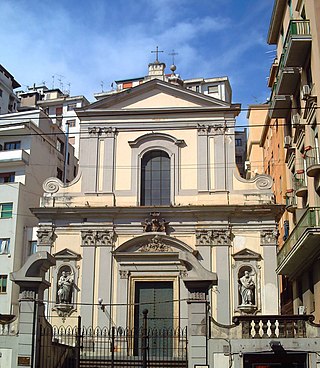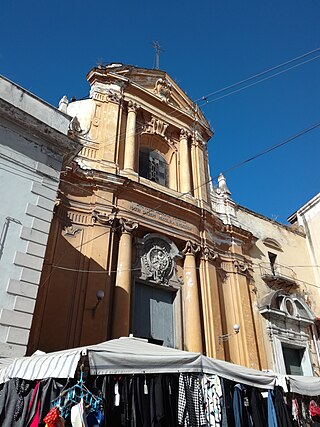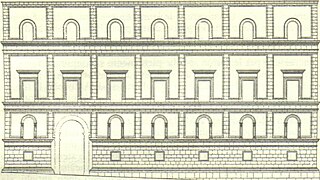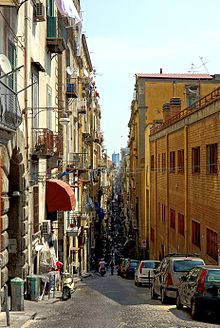
The properties of the Holy See are regulated by the 1929 Lateran Treaty signed with the Kingdom of Italy. Although part of Italian territory, some of them enjoy extraterritoriality similar to those of foreign embassies.

Monti is the 1st rione of Rome, Italy, identified by the initials R. I, located in Municipio I. The name literally means 'mountains' in Italian and comes from the fact that the Esquiline, the Viminal Hills, and parts of the Quirinal and the Caelian Hills belonged to this rione: currently, however, the Esquiline Hill belongs to the rione Esquilino.

Ponte is the 5th rione of Rome, Italy, identified by the initials R. V, and is located in Municipio I. Its name comes from Ponte Sant'Angelo, which connects Ponte with the rione of Borgo. This bridge was built by Emperor Hadrian in 134 AD to connect his mausoleum to the rest of the city. Though Pope Sixtus V changed the rione limits, so that the bridge belongs now to Borgo, not to Ponte anymore, the area has kept its name and a bridge as its coat of arms.

Quartieri Spagnoli is a part of the city of Naples in Italy. The Neapolitan language is stronger here than anywhere else. The area, encompassing c. 800,000 square metres, consists of a grid of around eighteen streets by twelve, including a population of some 14,000 inhabitants.

Via dei Tribunali is a street in the old historic center of Naples, Italy.

The Via Giulia is a street of historical and architectural importance in Rome, Italy, which runs along the left (east) bank of the Tiber from Piazza San Vincenzo Pallotti, near Ponte Sisto, to Piazza dell'Oro. It is about 1 kilometre long and connects the Regola and Ponte Rioni.

San Lorenzo is a district of Naples, Italy. It incorporates the precise geographical center of the ancient Greco-Roman city, centered on the intersection of Via San Gregorio Armeno and Via dei Tribunali.

In Roman urban planning, a decumanus was an east–west-oriented road in a Roman city or castrum. The main decumanus of a particular city was the decumanus maximus, or most often simply "the decumanus". In the rectangular street grid of the typical Roman city plan, the decumanus was crossed by the perpendicular cardo, a north–south street.

The districts of Naples are the sectors that, within the city, are identified by particular geographical and topographical, functional and historical features.

Rione Sanità is a neighbourhood in Naples, part of the Stella quarter. It is located north of Naples' historical centre, adjacent to the Capodimonte hill.

San Giorgio dei Genovesi is a church on Via Medina in the Center of Naples, Italy. It is adjacent and just north of the Church of the Santa Maria Incoronata, two doors south from the Palazzo d’Aquino di Caramanico, and across the street from the Church of the Pietà dei Turchini.

Santa Maria della Mercede e Sant'Alfonso Maria de' Liguori is a Roman Catholic church located in via San Sebastiano #1 in the historic center of Naples, Italy. It rises on the South-Eastern corner of the intersection of Via San Sebastiano - Via Santa Maria di Constantinopoli, and the Vico San Pietro da Maiella and the outlet of the Via Port'Alba, a narrow alley starting at the medieval gate of Port'Alba. The Vico San Pietro da Maiella feeds into the southernmost end of Via dei Tribunali, corner with via San Sebastiano, and on the Vico, neighboring to the east and behind the church, stands the Conservatory of San Pietro a Majella.

Giuseppe Astarita was an Italian architect and engineer of the late-Baroque or Rococo period. He was a pupil of Domenico Antonio Vaccaro and collaborated with Ferdinando Sanfelice; his style is influenced by Guarino Guarini. He worked on the following buildings, sometimes in work of reconstruction.

The Palazzo del Panormita is a Renaissance style palace in central Naples. It rises alongside the narrow via Nilo, near via Spaccanapoli, where it is called San Biagio dei Librai, diagonally from Santa Maria Assunta dei Pignatelli, adjacent to the Piazza del Nilo with the Nile God statue. It is south of Palazzo d’Afflitto and the Palazzo Spinelli di Laurino. The palace was initially commissioned prior to 1450 by Antonio Beccadelli, (1394–1471), called Il Panormita, who was a prominent Italian poet, canon lawyer, scholar, diplomat, and chronicler. It has since gone through many owners, including Giacomo Capece Galeota, a regent in the Tribunal of the Vicariate.
The Decumano or Decumanus Superiore was one of the three main east-west roads (Decumani) in the Ancient Roman city of Naples.

Palazzo di Sangro, also known as either Palazzo de Sangro di Sansevero or Palazzo Sansevero, is a late-Renaissance-style aristocratic palace facing the church of San Domenico Maggiore, separated by the via named after the church, in the city center of Naples, Italy. Part of the palace facade faces the piazza in front of the church, which is also bordered to the south by the Palazzo di Sangro di Casacalenda.

The Palazzo di Sangro di Casacalenda is an 18th-century aristocratic palace located across a piazza from the church of San Domenico Maggiore in central Naples, region of Campania, Italy. The East flank of the facade faces the facade of the church of Sant'Angelo a Nilo.
Naples (Italy) and its immediate surroundings preserve an archaeological heritage of inestimable value and among the best in the world. For example, the archaeological park of the Phlegraean Fields is directly connected to the centre of Naples through the Cumana railway, and the nearby sites of Pompeii, Herculaneum, Stabiae and Oplontis are among the World Heritage Sites of UNESCO.


















